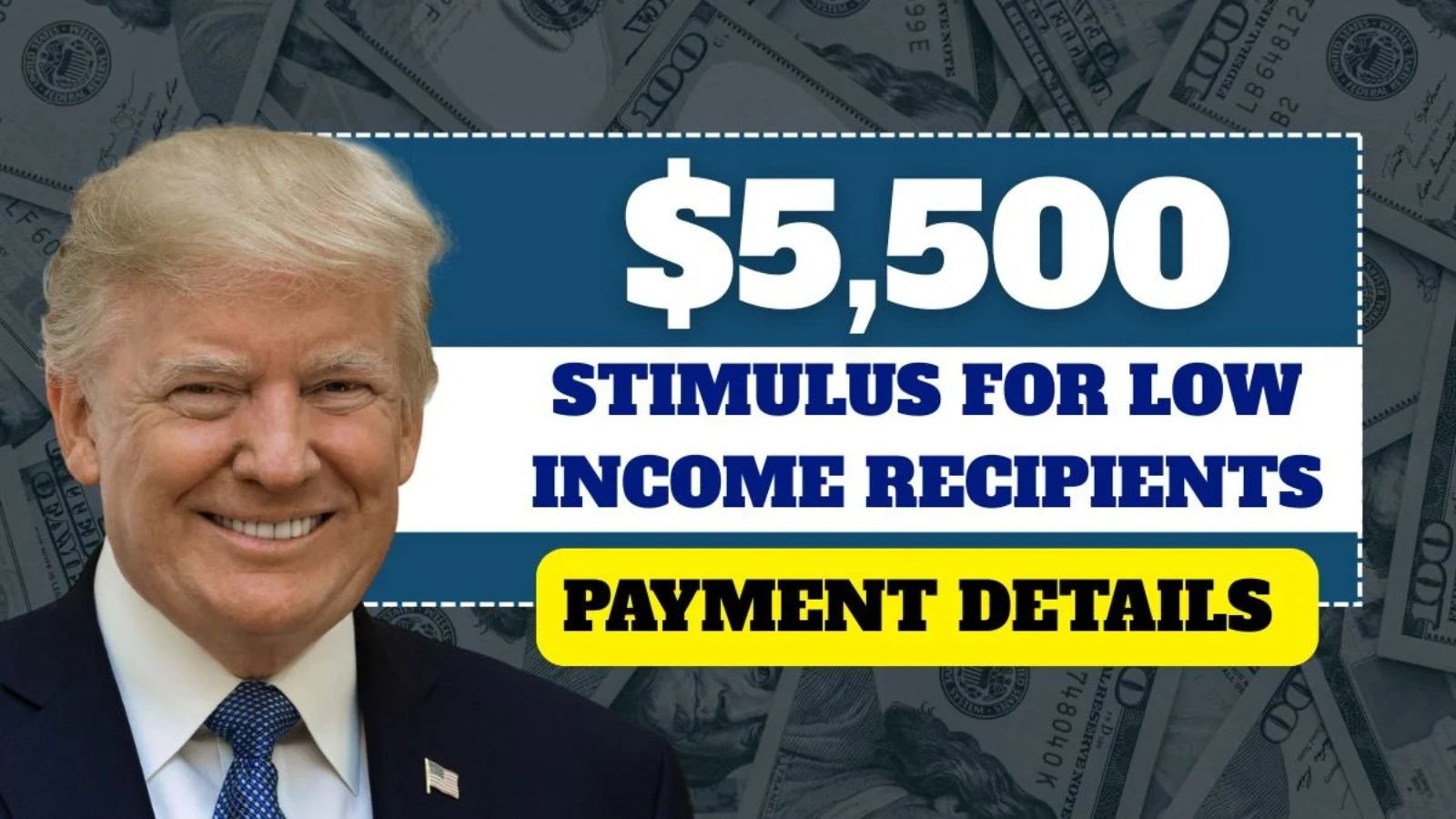In early April 2025, a wave of news reports and social media posts began spreading across the United States, claiming that the federal government was preparing to issue a brand-new round of direct relief payments to citizens. Specifically, it was suggested that Americans could soon receive either a $2,500 payment or even a $5,500 Stimulus check aimed at helping Supplemental Security Income (SSI) recipients, Social Security Disability Insurance (SSDI) beneficiaries, Veterans Affairs (VA) beneficiaries, and low-income taxpayers.
This story quickly gained traction, particularly among households that have relied heavily on past government relief measures, as well as those struggling with inflation and rising living costs. With the memory of pandemic-era stimulus payments still fresh in people’s minds, the idea of another $5,500 Stimulus understandably generated both hope and confusion.
But the most pressing question remains: is this true or simply another rumor amplified online? To answer this, let’s take a deep dive into the background, the history of stimulus checks, what’s currently official, and what Americans should realistically expect moving forward.
The Status of the $2,500 and $5,500 Stimulus Rumor
The first and most important point to clarify is that, as of today, there has been no official announcement from either the U.S. government or the Internal Revenue Service (IRS) confirming a new $2,500 or $5,500 Stimulus payment.
At present, the IRS continues to process older claims related to the 2021 Recovery Rebate Credit, with about one million individuals still eligible for payments of up to $1,400. However, these payments are strictly tied to past legislation and have no connection to any rumored $2,500 or $5,500 Stimulus checks.
This means that, while the rumors may sound promising, they currently exist only as speculation, without legal or legislative backing. Until Congress passes a law authorizing a new relief package, the talk of an upcoming $5,500 Stimulus remains unverified.
How Did the $5,500 Stimulus Rumor Begin?
The origins of this viral claim can be traced to a combination of online news portals, blog sites, and YouTube channels. Many of these platforms speculated that, with inflation still high and household budgets under strain, the federal government might consider another stimulus initiative.
Over time, some outlets presented this speculation as if it were confirmed news, and social media amplified the claims further. As more people shared posts referencing a $5,500 Stimulus, the rumor began to feel like fact—even though no official sources supported it.
Looking back at history helps us understand why people were quick to believe it. Stimulus checks have been issued before during times of national crisis:
- 2001: A $300 rebate was provided during the early 2000s economic downturn.
- 2008: A $600 stimulus was distributed to counter the Great Recession.
- 2020: A $1,200 payment helped households navigate the start of the COVID-19 pandemic.
- 2021: A $1,400 payment provided additional relief as the pandemic continued.
Given this precedent, it’s understandable why many assumed another round of payments—such as a $5,500 Stimulus—could be possible in the face of current economic challenges.
Who Could Be Eligible If a $5,500 Stimulus Is Approved?
While no official details exist, past stimulus programs give us a blueprint of who might qualify if such a program were to be enacted. Eligibility would likely focus on income limits, household filing status, and federal program participation. Potential criteria could include:
- Single filers: Full payments for individuals with adjusted gross income (AGI) up to $75,000.
- Married couples filing jointly: Full payments for households earning up to $150,000.
- Phase-outs: Reduced payments for those earning above these thresholds, with complete disqualification after a higher income limit.
- Automatic eligibility: For SSI, SSDI, and VA beneficiaries, who typically receive payments without needing to file additional paperwork.
- Dependents: Extra funds for families with dependents, such as children, college students, or adults with disabilities.
If a $5,500 Stimulus check were ever approved, these groups would be among the primary beneficiaries, reflecting the same framework used in previous relief efforts.
Possible Payment Methods
If the government does eventually authorize a new round of stimulus checks, payments would likely be distributed using the same methods applied in prior relief programs. The three primary methods are:
- Direct Deposit: The fastest and most secure way for funds to reach recipients, with money sent directly into bank accounts.
- Paper Checks: Issued to those who either don’t use direct deposit or prefer physical checks. While slower, this method remains widely used.
- Prepaid Debit Cards: A convenient alternative for individuals without a bank account, allowing immediate use of funds for purchases or withdrawals.
To prepare for the possibility of a $5,500 Stimulus, households are encouraged to ensure their IRS and Social Security Administration (SSA) records are accurate and up-to-date. This includes verifying addresses, bank account information, and tax filings.
When Could a $5,500 Stimulus Arrive?
Currently, there is no official timeline since the program itself has not been approved. However, examining the timelines of previous stimulus rollouts gives us a general sense of what to expect.
Typically, the process begins with Congress passing legislation. Once the bill is signed into law by the President, the IRS is tasked with distribution. Historically, the first direct deposits begin reaching accounts within 2–3 weeks of approval, followed by paper checks and debit cards over the next several weeks.
For most Americans, receiving a stimulus check has generally taken 1–3 months from the date of legislative approval. Therefore, even if a $5,500 Stimulus were announced in the coming months, payments would not realistically begin until weeks later.
What Should You Do to Prepare?
Even though the news of a $5,500 Stimulus is not confirmed, it’s always wise to be prepared in case new relief measures are announced. Here are some proactive steps:
- File Tax Returns Promptly: Stimulus eligibility is often tied to recent tax filings. Make sure your 2023 and 2024 tax returns are complete.
- Update Banking Information: Ensure that your direct deposit details are current with the IRS and SSA. This prevents delays.
- Check Addresses: If you receive paper checks, make sure your mailing address is correct to avoid misdelivery.
- Rely on Official Sources: Always verify information through the official IRS website or government announcements before believing or sharing news.
- Use the “Get My Payment” Tool: In past programs, this IRS tool allowed millions of Americans to track their stimulus checks in real time.
By following these steps, you can position yourself to benefit quickly if a $5,500 Stimulus check ever becomes a reality.
Why People Are Eager for a $5,500 Stimulus
The excitement surrounding the rumor of a $5,500 Stimulus is not surprising when you consider current economic conditions. Inflation has continued to push up the cost of food, fuel, and housing, squeezing middle- and low-income families. Many seniors and disabled Americans relying on fixed incomes, such as SSI and SSDI, are finding it increasingly difficult to manage daily expenses.
For these households, the possibility of receiving $2,500—or even more substantially, a $5,500 Stimulus—represents not just financial relief but also reassurance that the government is attentive to their struggles. Past experience has shown that such payments can provide a vital cushion, reducing debt burdens and boosting local economies as recipients spend the money on essentials.
Conclusion: Just a Rumor for Now, But Stay Informed
At the moment, the claims about a $2,500 or $5,500 Stimulus check are not based on any official action by Congress or the IRS. These reports are rumors amplified by blogs, YouTube channels, and social media. However, history shows that stimulus checks often become a reality during periods of economic stress.
That means while nothing has been confirmed yet, it is still smart for citizens—especially SSI, SSDI, VA beneficiaries, and low-income taxpayers—to stay informed, keep financial records updated, and be ready if an announcement is made in the future.
Until an official statement comes from the U.S. government, treat all claims of a $5,500 Stimulus as speculation. Still, with the economic climate creating real hardships for millions, the possibility of another round of direct relief should not be ruled out entirely.
FAQs on the $5,500 Stimulus
Q. Is the $5,500 Stimulus check confirmed by the U.S. government?
A. No. There has been no official confirmation from the U.S. government or the IRS regarding a new $5,500 payment.
Q. Who could qualify if the stimulus is approved?
A. Likely recipients would include SSI, SSDI, VA beneficiaries, and low-income taxpayers who meet income and filing criteria.
Q. How would payments be distributed?
A. Through direct deposit, paper checks, or prepaid debit cards, depending on each recipient’s circumstances.
Q. When could payments be issued?
A. Historically, payments start within 2–3 weeks of approval, but full distribution often takes 1–3 months.
Q. Where can I check my stimulus payment status?
A. On the official IRS website, using the “Get My Payment” tool when it becomes available.
Some Important Link
| Download News APP | Click Here |
| WhatsApp Group | Click Here |
| Home Page | Click Here |





